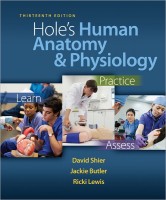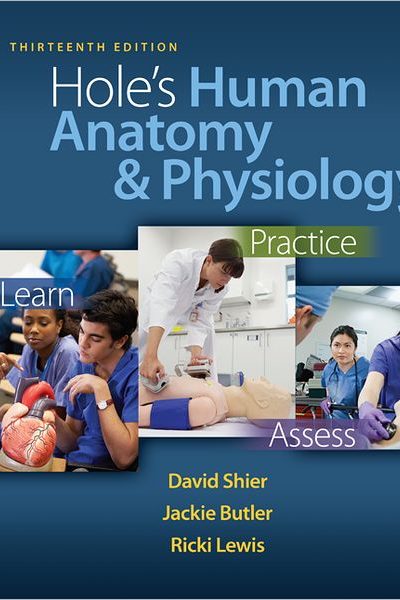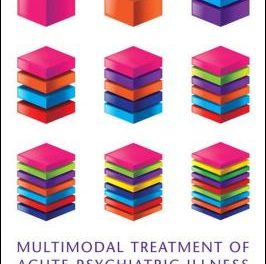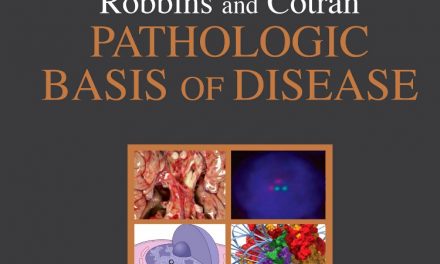 Authors: David Shier, Jackie Butler, and Ricki Lewis. Digital Authors: Leslie Day and Julie C. Pilcher
Authors: David Shier, Jackie Butler, and Ricki Lewis. Digital Authors: Leslie Day and Julie C. Pilcher
Publisher: McGraw-Hill – 997 pages
Book Review by: Nano Khilnani
To benefit the most from the use of this book, we urge you to use its online resources as well, which are found on: www.mhhe.com/shier13.
McGraw-Hill Connect Plus Anatomy & Physiology is an interactive learning platform that provides a customizable, assignable eBook, auto-graded assignments, an adaptive diagnostic tool, lecture capture, access to instructor resources, and powerful reporting – all in an easy-to-use interface. Learn more at: www.mcgrawhillconnect.com
A third website useful to you is: www.mhlearnsmart.com. McGraw-Hill LearnSmart is an adaptive diagnostic tool that constantly assesses student knowledge of course material. Sophisticated diagnostics adapt to each student’s individual knowledge base, and vary the questions to determine what the student knows, doesn’t know, knows but has forgotten, and how to best improve their knowledge level. Students actively learn required course concepts, and instructors can access specific LearnSmart reports to monitor progress.
This massive book of nearly a thousand pages has 24 chapters covering numerous topics on the subject of human anatomy and physiology. The chapters are organized around six main sections, namely:
- Levels of Organization
- Support and Movement
- Integration and Coordination
- Transport
- Absorption and Excretion
- The Human Lifecycle
Levels of Organization deals with how the human body is organized, with an introduction to human anatomy and physiology, the chemical basis of life, cells, cellular metabolism, and tissues.
Support and Movement essentially illustrates and explains how our body is structured with a system of bones, protected with skin, and moves with our system of muscles.
Integration and Coordination basically shows us how our nervous systems and our endocrine system coordinate our thinking and actions.
Transport contains three chapters that focus on how the blood in our arteries and veins moves through our cardiovascular system and how our lymphatic system provides us immunity from attacks.
Absorption and Excretion demonstrates to us: how our gastrointestinal tract (digestive and excretory system) processes the food we eat and gives us the nutrition and metabolism we need; how respiratory system enables us to breathe the oxygen we need and expel the chemicals we don’t need; how our urinary system processes needed liquids and expels waste; and these systems working together provide the water, electrolyte and acid-base balance we need. Hole’s Human Anatomy & Physiology, 13th edition
The Human Life Cycle details for us the functioning of our reproductive systems; the role of pregnancy in human gestation; how growth and development ensues after fertilization; and the role of genetics and genomics.
This book is based on the McGraw-Hill theme of Learn, Practice and Assess. Even though we have not featured all of the tools the publisher and the authors of this book have provided in it to help students go through this cycle of three functions, we trust you will use them to benefit the most from this book.
All the authors working together have done a great job to make this book as useful as possible for you. As always, there is room for improvements, and I am sure the fourteenth edition will have some of them.
Authors:
David Shier, PhD has been teaching anatomy, physiology and pathophysiology at Washtenaw Community College in Ann Arbor, Michigan since 1990, and has contributed to the Hole texts since 1993. He began his career as a research assistant at Harvard Medical School from 1976 until 1979. He then began to study for his PhD at the University of Michigan and completed his program in 1984. He then joined the faculty of Ohio Medical College in 1985 and served there until 1989.
Jackie Butler began her science career at M.D. Anderson Hospital, from where she obtained a Masters degree. After that she taught labs for three years at Texas A&M University. She then took a teaching position in 1981 at Grayson County College, where has been since then, and where she feels “excited and enthusiastic about being in the classroom.”
Ricki Lewis, who has a PhD in Genetics, is a science writer. Besides being a coauthor of this book, she is the author of Human Genetics: Concepts and Applications, now in its tenth edition. She teaches “Genethics” online for the Alden March Bioethics Institute of Albany Medical College, and is an instructor for the Union College Academy of Lifelong Learning.
Digital Authors:
Leslie Day has a B.S. in Exercise Physiology from the University of Massachusetts at Lowell, an M.S. in Applied Anatomy and Physiology from Boston University, and a PhD in Biology from Northeastern University, where she did research on the kinematics of locomotion. She works as an Assistant Clinical Professor in the Physical Therapy Department at Northeastern University, with her main teaching role in Gross Anatomy and Neuroanatomy, and won the Excellence in Teaching Award in 2009.
Julie C. Pilcher was first exposed to teaching during her graduate training in Biomedical Sciences at Wright State University in Dayton, Ohio. She found that working as a teaching assistant held her interest more than her research. After completing her degree in 1986, she began her teaching career as an adjunct in a variety of schools for many years. In 1998, she began full-time teaching at the University of Southern Indiana in Evansville. In recent years she has been in involved in content development for LearnSmart.







